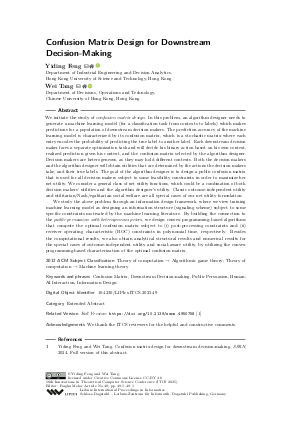LIPIcs.ITCS.2025.49.pdf
- Filesize: 373 kB
- 1 pages

 Creative Commons Attribution 4.0 International license
Creative Commons Attribution 4.0 International license

We initiate the study of confusion matrix design. In this problem, an algorithm designer needs to generate a machine learning model (for a classification task from contexts to labels) which makes predictions for a population of downstream decision makers. The prediction accuracy of the machine learning model is characterized by its confusion matrix, which is a stochastic matrix where each entry encodes the probability of predicting the true label to another label. Each downstream decision maker faces a separate optimization task and will decide his binary action based on his own context, realized prediction given his context, and the confusion matrix selected by the algorithm designer. Decision makers are heterogeneous, as they may hold different contexts. Both the decision makers and the algorithm designer will obtain utilities that are determined by the actions the decision makers take, and their true labels. The goal of the algorithm designer is to design a public confusion matrix that is used for all decision makers subject to some feasibility constraints in order to maximize her net utility. We consider a general class of net utility functions, which could be a combination of both decision makers' utilities and the algorithm designer’s utility. Classic outcome-independent utility and utilitarian/Nash/egalitarian social welfare are all special cases of our net utility formulation. We study the above problem through an information design framework, where we view training machine learning model as designing an information structure (signaling scheme) subject to some specific constraints motivated by the machine learning literature. By building the connection to the public persuasion with heterogeneous priors, we design convex programming-based algorithms that compute the optimal confusion matrix subject to (i) post-processing constraints and (ii) receiver operating characteristic (ROC) constraints in polynomial time, respectively. Besides the computational results, we also obtain analytical structural results and numerical results for the special cases of outcome-independent utility and social-aware utility, by utilizing the convex programming-based characterization of the optimal confusion matrix.
Feedback for Dagstuhl Publishing